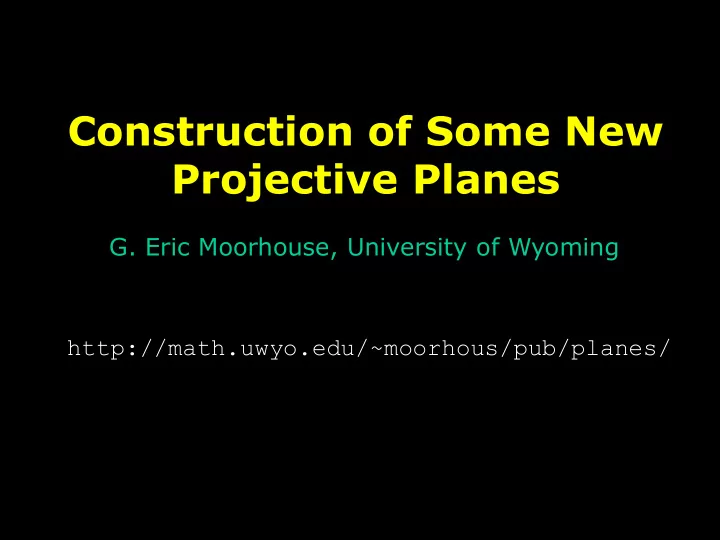

Construction of Some New Projective Planes G. Eric Moorhouse, University of Wyoming http://math.uwyo.edu/~moorhous/pub/planes/
n 2 3 4 5 7 8 9 11 number of planes 1 1 1 1 1 1 4 1 of order n known n 13 16 17 19 23 25 27 29 number of planes 1 22 1 1 1 193 13 1 of order n known
Known Planes of Order 25 Translation planes a1,…,a8; b1,…,b8; s1,…,s5 classified by Czerwinski & Oakden (1992)
The Wyo m ing Plains
| Aut(w1) | = 19200 | Aut(w2) | = 3200 The Wyo m ing Planes
Thanks to my coauthor…
Where do the new planes come from?
4 1 3 2 3 2 1 4 quotient by t , an automorphism of order 2 3 1 4 2
4 4 1 1 3 3 2 2 3 3 2 2 1 1 4 4 3 1 4 2
Given a projective plane P with involution t 2 Aut(Π), let Π/ t be the incidence structure induced on point and line orbits of size 2. Π/ t yields a cell complex Δ having • vertices (0- cochains ): points, blocks of Π/ t • edges (1- cochains ): flags of Π/ t • square faces (2- cochains): “digons” of Π/ t C i = C i (Δ, F 2 ) = F 2 -space of i -cochains d 0 d 1 coboundary map C 0 ! C 1 ! C 2 H 1 = H 1 (Δ, F 2 ) = ker d 1 / im d 0
If H 1 = 0 then Π/ t lifts uniquely back to Π. Theorem. Equivalence classes of orbits of Aut(Π/ t ) pairs (Π, t ) covering on H 1 (Δ, F 2 ) the same Π/ t C i = C i (Δ, F 2 ) = F 2 -space of i -cochains d 0 d 1 coboundary map C 0 ! C 1 ! C 2 H 1 = H 1 (Δ, F 2 ) = ker d 1 / im d 0
If H 1 = 0 then Π/ t lifts uniquely back to Π. Theorem. Equivalence classes of orbits of Aut(Π/ t ) pairs (Π, t ) covering on H 1 (Δ, F 2 ) the same Π/ t actually, a particular coset of H 1 = Z 1 / B 1 in C 1 / B 1 … C i = C i (Δ, F 2 ) = F 2 -space of i -cochains d 0 d 1 coboundary map C 0 ! C 1 ! C 2 H 1 = H 1 (Δ, F 2 ) = ker d 1 / im d 0
If H 1 = 0 then Π/ t lifts uniquely back to Π. Theorem. Equivalence classes of orbits of Aut(Π/ t ) pairs (Π, t ) covering on H 1 (Δ, F 2 ) the same Π/ t In all cases I have examined, dim H 1 (Δ, F 2 ) ∙ 4.
For any given plane Π, • compute G =Aut(Π); • find a representative t for each conjugacy class • of involutions in G; • compute H 1; • if H 1 ≠ 0, find orbits of Aut(Π/ t ) on H 1 .
Known Planes of Order 25 Translation planes a1,…,a8; b1,…,b8; s1,…,s5 classified by Czerwinski & Oakden (1992)
Other instances of non-unique lifting (among planes of order 16) Johnson-Walker Dempwolff plane plane quotient
Other instances of non-unique lifting (among planes of order 16) Lorimer-Rahilly derived semifield plane plane quotient
Other instances of non-unique lifting (among planes of order 16) semifield plane semifield plane over F 4 over F 2 quotient
Other instances of non-unique lifting (among planes of order 16) Mathon dual Mathon plane plane quotient
Other instances of non-unique lifting (among planes of order 9) Desarguesian Hughes plane plane quotient
Why only consider involutions t 2 Aut(Π)? In this case the problem of lifting Π/ t to Π amounts to solving a linear system. In any double cover, the fibres are necessarily t -orbits for some involution t .
Also tested: • the 18 smallest known generalised quadrangles; • the 4 smallest known generalised hexagons; • the smallest known generalised octagon. In only one case is H 1 nontrivial: dim H 1 = 1 for the GQ with s =3, t =5. We are having to solve linear systems over F 2 with thousands of unknowns. Space constraints (computer memory) is the chief limitation in testing larger generalised polygons.
Recommend
More recommend